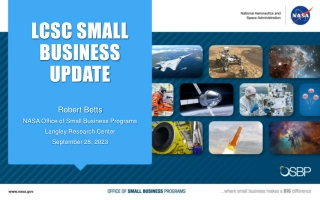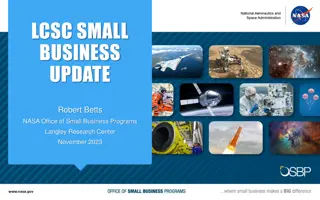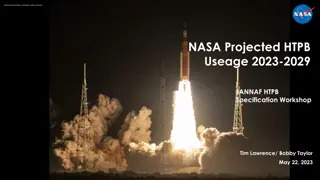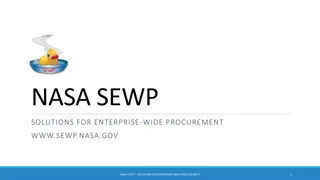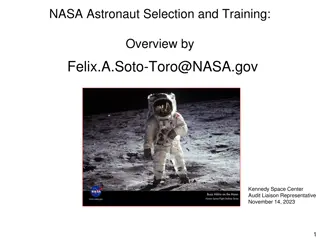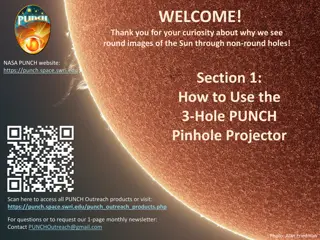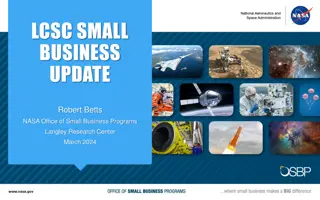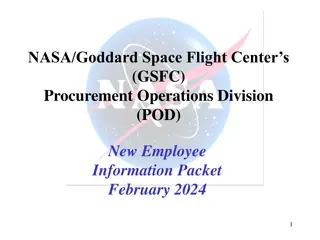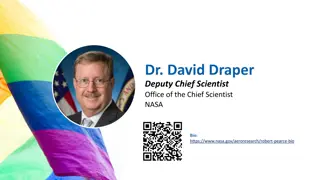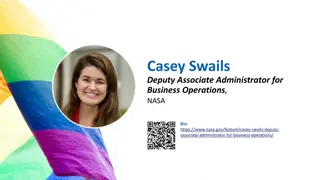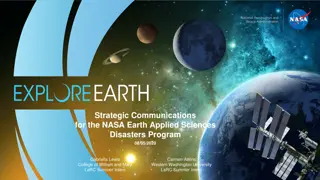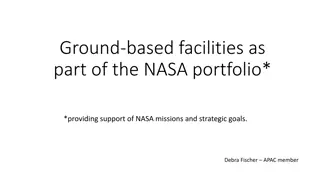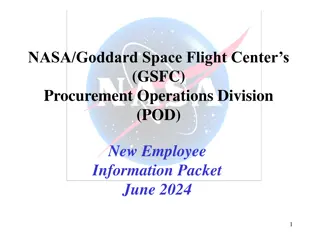Reflections on NASA Science and Lessons for the Future
Retired NASA lead Diane E. Wickland shares insights on past generations of NASA science, emphasizing the importance of learning from past experiences for shaping the future of space exploration and research priorities. Wickland delves into the evolution of science priorities, funding challenges, and the dynamic nature of NASA programs over the years.
Download Presentation

Please find below an Image/Link to download the presentation.
The content on the website is provided AS IS for your information and personal use only. It may not be sold, licensed, or shared on other websites without obtaining consent from the author.If you encounter any issues during the download, it is possible that the publisher has removed the file from their server.
You are allowed to download the files provided on this website for personal or commercial use, subject to the condition that they are used lawfully. All files are the property of their respective owners.
The content on the website is provided AS IS for your information and personal use only. It may not be sold, licensed, or shared on other websites without obtaining consent from the author.
E N D
Presentation Transcript
A Perspective on Past A Perspective on Past Generations of NASA Science and Generations of NASA Science and Lessons Learned Relevant for Lessons Learned Relevant for Your Future Your Future Diane E. Wickland, Retired Diane E. Wickland, Retired (former Lead for NASA Carbon (former Lead for NASA Carbon Cycle and Ecosystems Focus Area) Cycle and Ecosystems Focus Area)
Why I am Here Today Why I am Here Today -- -- This is a Personal Perspective This is a Personal Perspective The workshop organizing committee told me they thought I might have a perspective worth sharing with you soon after my retirement. I joined NASA HQ s Office of Space Science and Applications (OSSA) in 1985 as a detailee from the Jet Propulsion Laboratory, so this is an ~30-year perspective. Many things have changed since then; many others have not. I believe it is always unwise to assume the past will be an indicator of the future. However, hard-earned lessons learned should be taken into account as one moves forward. I am going to focus primarily on my experiences with the NASA Terrestrial Ecology Program. Major Caveat: I know that different people experiencing / witnessing the same events do not recall them in the same way; who you are and where you stood, as well as the fidelity of your memories over time, influence what you remember and what you think about those events.
The Pendulum of Science Priorities and Funding: The Pendulum of Science Priorities and Funding: A pre A pre- -NASA Lesson Learned NASA Lesson Learned Eugene Odum shared this perspective: funding / national priorities for environmental (and other) science or approaches will wax and wane over time, rather like a pendulum swinging back and forth. So do not despair and stay the course, knowing things will get better (this said after Reagan took office in 1981 and made drastic cuts to funding for environmental science) And be prepared to make the best of the more favorable times that will surely come . . . I have seen the pendulum swing back and forth a couple of times now for basic versus applied science, funding for Earth observing missions, etc. and believe this perspective has some value. This pendulum analogy also seems to apply for some NASA policies and practices and how its legal/procurement offices interpret laws and implement policies . . .
Past Generations of NASA Science Past Generations of NASA Science N A S A Earth System Science: Utilizing EOS & First Decadal Survey Data Slow, but Spectacular NRC Decadal Survey (2007) Aquarius Budget Decline Climate Initiative (2010) Congressional Direction LACIE & AgRISTARS Earth System Science: Preparing for EOS Landsat, SeaWiFS Global Habitability The Bretherton Report USGCRP Reorganizing/Restructuring EOSDIS Agricultural Crop Production SMAP OSTM Landsat (1972) AVHRR (1978) Seasat & CZCS (1978) Terra Aqua Aura Landsat-8 GPM, OCO Suomi NPP 1970 D i a n e 1980 1990 2000 2010 2020 Seeking More Ingredients, Treading Water, & Burning Out Making Sausage & Trying to Stay Out of Hot Water Learning How the Sausage is Made Innovated for ESS/EOS: IDS, Pathfinder Data, Airborne/Field Campaigns Re-organized (repeatedly) Changed with the Times I was Mentored & Trained Defined a New Program Spread the Word (about ESS & EOS) Advanced Carbon Science Strived for New Missions Managed a Shrinking Budget Helped Colleagues Work the NASA System Shock & Awe Running Scared Just Running
LACIE / AgRISTARS LACIE / AgRISTARS
LACIE / AgRISTARS LACIE / AgRISTARS LACIE used Landsat to estimate global wheat production; AgRISTARS expanded this to address many other crops. When I arrived at NASA HQ, these programs were viewed as failures -- fundamentally flawed because the correlative, empirical relationships were not generalizable -- and the budget supporting them had crashed. This was a little unfair. The methods did work within certain constraints and led to USDA s current agricultural crop production monitoring. With its much reduced budget, NASA took a back to basics approach with the intent to develop theoretically sound, physically-based approaches to analyzing satellite data: Set up a Fundamental Remote Sensing Science program element Recruited disciplinary scientists to get the Land Processes research on a firmer scientific basis Lesson Learned (LL): Empirical work can yield useful results, but without understanding of the underlying mechanisms, it will likely run its course and fall out of favor. LL: If you cannot continue to deliver answers, information, desired knowledge or are perceived as such -- you will lose funding.
Preparing for EOS Preparing for EOS
Earth System Science: Earth System Science: Preparing for EOS Preparing for EOS In the early 1980 s NASA s Life Sciences and Earth Applications programs, along with many U.S. community scientists, developed ideas related to studying long term changes that may affect the habitability of the Earth. I was told that early efforts to sell this Global Habitability concept as the next big thing did not go well, suffering from the not invented here syndrome. This was followed by three streams of activity to further develop, refine, and build acceptance for these ideas: Planning within the international scientific community and ICSU to develop the International Geosphere- Biosphere Programme (established in 1986). Planning largely by NASA to make the space-based observations to support it. This led to the 1986 Bretherton report entitled Earth System Science: Overview, followed in 1988 by Earth System Science: A Closer View, and NASA s 1988 call for EOS proposals. Discussions within the U.S. Government led by NASA, NSF, and NOAA to craft an interagency approach to global change science, followed by the establishment of the U.S. Global Change Research Program as a Presidential Initiative in 1989 and Congressional action to pass the Global Change Research Act of 1990 to assist the Nation and the world to understand, assess, predict, and respond to human-induced and natural processes of global change.
Lessons Learned (LL): Lessons Learned (LL): Preparing for EOS Preparing for EOS LL: Good ideas (even really good ones) need lots of development and refinement this usually takes time and many of the best minds of the world (at least a decade for ESS!). LL: Good ideas need widespread buy-in and ownership on the part of diverse stakeholders: The U.S. scientific community The international scientific community Other Federal agencies and the Executive Branch Congress The public Etc.
Earth System Science: Earth System Science: Preparing for EOS Preparing for EOS After ESS & EOS were established, but prior to launch of Terra, NASA spent the 1990 s: Re-organizing, re-structuring, re-baselining, etc. (and developing) the EOS program (major reviews by NRC approximately every 2-3 years). Re-organizing NASA HQ (every ~2-4 years, if my memory is correct). In 1992 OSSA was dissolved and two new offices created: Mission to Planet Earth and Planetary Science & Astrophysics During this period and thereafter, Earth Science projects, programs, branches and sub-divisions were shuffled around with great regularity This is the period when many new approaches and processes were innovated for managing and implementing NASA Earth Science Struggling to develop EOSDIS.
Lessons Learned (LL): Lessons Learned (LL): Preparing for EOS Preparing for EOS LL: Reorganizing is very disruptive and can be very hard on the Program Managers affected (too much uncertainty), but, at least in a time of growing/healthy budgets it does not much affect the actual research/missions supported. LL: It can be good to plan for something really big and integrated at least if it has many somewhat separable elements because after whatever re-organizing, re- structuring, re-baselining, etc. occurs there will still be something worth doing. LL: Be careful developing major dependencies on something big and brand new that your organization has never done before (i.e., EOSDIS)!
Earth System Science: Earth System Science: Preparing for EOS Preparing for EOS So what was I doing during this period? Building up a Terrestrial Ecology (TE) program to be ready to conduct Earth System Science utilizing EOS sensor data (starting budget was $2M, rose to $20M in ~2004 and then slowly declined to ~$14M in 2014) and helping the Land Processes Branch in similar work in the areas of remote sensing science, hydrology, land cover, and geology: Remote sensing science Data sets to simulate EOS data Process studies to fill gaps in understanding to enable effective utilization of new satellite data Model development in order to have good models capable of utilizing the new satellite data Advancing Field Campaigns as an important program element Working with the community to develop Advance Plans/Strategies for future TE research Helping to establish and advance Interdisciplinary Science (IDS) and research-enabling data stewardship (EOSDIS and related activities) as major NASA program elements. We were making much of this up as we went along; inventing new processes, programs, and ways of doing business (this was true on the mission side as well!).
Earth System Science: Earth System Science: Preparing for EOS Preparing for EOS Toward the end of the 1990 s, certain elements of the approach to Terrestrial Ecology (TE) were wearing thin and I was criticized for having a program too NSF-like and/or not sufficiently focused on what NASA does. The remote sensing science element became increasingly viewed as too esoteric and fundamental to be necessary. Initially, I defended it, then I buried it within the Terrestrial Ecology Program. It survives today only as very focused research preparatory for new missions. (However, recently, ESD decided it needed a Remote Sensing Theory Program element!) The process research became more and more viewed as the purview of other agencies and not NASA. I viewed this as a logical evolution of the program, but was very slow to make changes. While the TE program still does some process research, it is now always very closely tied to a remote sensing need/application. The success of IDS research was opening new opportunities for interdisciplinary research that emphasized close interactions/partnerships with other NASA disciplinary programs. (I was faster to move here!)
Lessons Learned (LL): Lessons Learned (LL): Preparing for EOS Preparing for EOS LL: As the pendulum swings, a Program Manager and the scientists in the program need to change with it. Be adaptable. There is usually more than one way to sell (i.e., justify) a research topic, field program, or satellite mission or to get needed work done by others. Be prepared. There will be opportunities to do new things (sometimes with your own resources and sometimes leveraging new or other resources) and you need to be ready to jump on them. You cannot (usually) invent something scientifically valuable overnight unless you have done some planning and preparation, so . . . Always have some type of community-vetted advance plan at hand! It can be either custom for your NASA program, discipline, or division or more broadly applicable nationally or internationally (e.g., IGBP plans, A U.S. Carbon Cycle Science Plan). LL: Theory without being applied (sooner or later) to science or society will not be valued and is unlikely to flourish (except maybe in some political environments).
Other Perspectives Gained While Other Perspectives Gained While Preparing for EOS Preparing for EOS Nothing actually happens quite the way you think it does or should A carefully reasoned, well-justified argument is essential, but often insufficient. Major, irrevocable decisions can be made in astonishing ways In the hallways (e.g., aircraft deployments abroad), As a consequence of an unrelated event (e.g., new carbon cycle science), Through inattention on the part of key people at a critical time (e.g., a 10-year LBA), By one person who may not have been aware of or thought through the consequences . . . Sometimes no reason is ever provided (or at least a good, understandable reason) for why a decision is made Some decisions stick and others end up easily (or ultimately) reversed. Science rationalizes what NASA does in Earth and Space missions, but after a solid scientific justification is established, it is all about the hardware/technology Lessons Learned from my first two bosses at NASA HQ: Everything NASA does is focused on building spacecraft and getting to space (Murphy), but if you are not doing world-class science, you aren t going anywhere (Watson)!
Utilizing EOS Data & Utilizing EOS Data & First Decadal Survey First Decadal Survey
ESS: ESS: Utilizing EOS Data & First Decadal Survey Utilizing EOS Data & First Decadal Survey After the launch of Terra in 1999 and Aqua in 2002, the world changed for NASA Earth Science and we clearly entered a new generation. However, it took 2+ years after the launch of each of these satellites for there to be any impact on the scientific content of most NASA Earth Science Programs. After all of that preparation, it still took several years for the data to be well enough understood and vetted for release for scientific use. The multiple restructurings of the 1990 s had reduced the EOS plan from a series of 3 sets of satellites to span 15 years of observations to one set to span a nominal 5 years, so it was immediately necessary for NASA to plan, and for the nation to invest anew, in what s next for there to be a future for NASA Earth Science. However, it wasn t going well: the budget was declining down (expensive satellites were launched and nothing that big was in the queue); large, flagship-type missions had gone into disfavor; the NOAA- DOD-NASA NPOESS partnership for continuity of many Terra and Aqua measurements was having lots of difficulties; the politicians in power were hostile to global change science . . .
ESS: ESS: Utilizing EOS Data & First Decadal Survey Utilizing EOS Data & First Decadal Survey NASA re-organized in 2004, merging the Earth and Space sciences into one Science Directorate, and that led to a consolidation of practices and policies that in many cases imposed the NASA Space Science culture and ways of doing business on Earth Science. The Earth Science Focus Areas, originally conceived to be staffed with a full-time lead and be fully integrative of all MTPE activities, morphed into their current informal, ad hoc status. All of the new ways of doing business and lessons learned in developing EOS and EOSDIS began to erode away in favor of the traditional ways NASA does business (as preserved within Space Science). It became essential that Earth Science s future program be guided by a National Research Council (NRC) Decadal Survey. Around 2004, EOS began delivering and living up to its potential. NASA research became more quantitative, interdisciplinary, synthetic, and productive. EOS data were readily available and being used around the world and EOSDIS was working!
Lessons Learned: Lessons Learned: Utilizing EOS Data & First Decadal Survey Utilizing EOS Data & First Decadal Survey LL: Never underestimate the amount of work or time it will take to do something fundamentally new: any new type of measurement, measurement concept, or science application, however well understood and prepared for in advance, will take more time than you think to yield scientifically meaningful results worthy of dissemination to the public and one s sponsors. Patience on all sides will be paramount! LL: For Program Managers (and all senior managers above them) there will be no time and little opportunity to enjoy current program and project successes priority time and attention must be given to the painful processes of seeking continuity and the next big thing(s) for the program s future. LL: Re-organizations can have strong effects on how NASA programs are implemented and can be a fast way to lose valuable lessons learned and new ways of doing business.
First Decadal Survey First Decadal Survey
ESS: ESS: First Decadal Survey First Decadal Survey The first Decadal Survey for Earth Science, Earth Science and Applications from Space: National Imperatives for the Next Decade and Beyond, was completed in 2007. Priority Science/Missions were identified by an NRC committee and its disciplinary subgroups. 17 different missions were recommended for 2010-2020. The report called for an ambitious program of focused, largely disciplinary missions and complementary research activities with budget increases to get back to earlier, ~ Year 2000 levels of funding.
ESS: ESS: First Decadal Survey First Decadal Survey Strengths: Many excellent scientists who cared about the future of Earth Science involved Community input via a call for White Papers on candidate missions (and lots of hard work went into those White Papers!) Consultation with the community during Town Hall-type meetings Weaknesses: Cost estimation was not rigorous White Papers development divided the NASA scientists and engineers in to somewhat competitive camps The broader scientific community was not heavily involved Continuity of many EOS data sets ( assured through NPOESS) was not addressed Surrounding Issues: To continue to have an interdisciplinary Earth System Science program, many different missions were needed over a relatively short period of time; This called for Earth Science budget increases that were (likely) unrealistic for the political/budgetary situation at that time
Lessons Learned (LL): Lessons Learned (LL): First Decadal Survey First Decadal Survey LL: Earth Science Program planning appears to work better with very broad community involvement, frequent interactions and iterations, and sufficient time to fully evaluate ideas and refine concepts. (ESS and EOS versus the First Decadal Survey) In difficult political and/or budgetary times, it may not be reasonable to develop a plan wholly dependent on major budget increases how then to secure a robust, integrated, interdisciplinary approach to Earth Science? Do we need to think more about how to better optimize within expected budgets? How much do we depend on partners in other agencies and nations for key contributions? Do we need a plan that can be pared down to degrade more gracefully, like EOS? This, in light of the fact that by 2020 we will be lucky to have 3 of the Decadal Survey missions in orbit (SMAP, ICESat-2, SWOT) or maybe ~6 if you count PACE, GRACE Follow-on, and NISAR? How interdisciplinary will this science be? As long as Terra, Aqua and Aura survive, you will not feel this so much. We are still in a Golden Age of satellite data for Earth Science, but it is far from clear whether this can continue into the 2020 s. Thus, the next Decadal Survey and how it is received will be crucial!
Other Activities Along the Way: Major Field Campaigns Other Activities Along the Way: Major Field Campaigns Major field campaigns (e.g., BOREAS, LBA, ABoVE) are high risk, high reward endeavors and should not be undertaken lightly. You need: A compelling world-class science issue/question to motivate and justify the investment A Program/Project Leaders willing and able to make the campaign their #1 priority Broad research community buy in and partnerships (interagency, international, local) NASA HQ (and lead Center) support to secure and retain priority access to resources LL: Risks must be recognized, accepted, and mitigated reasonably. Safety must be a top priority; however, things will happen: people will get sick / be injured and, very likely, people will die. Costly things will break/fail. You must be prepared to deal with these things! If working with non-U.S. partners, you must: 1) recognize and respond to political situations and threats, 2) not stress/violate U.S. policies and agendas or stress/impair valued relationships LL: Scientific results must significantly advance understanding and be viewed as worth the investment, but it is important to be careful what you promise because you may be held accountable. LL: Major field campaigns are becoming harder to implement within the research program because of competition with Venture Class and overburdened HQ managers.
A Few Other Perspectives of a Former Program Manager A Few Other Perspectives of a Former Program Manager NASA Policies and Practices are NOT optimized for scientific research. This is nowhere more apparent than in NASA s financial management approaches which are clearly optimized for managing large contracts and hardware (e.g., policies on uncosted carryover) ITAR and IT security considerations severely constrain international collaborations and the involvement of many foreign students in NASA research It is still a man s world at NASA. The fraction of female Principal Investigators in the CC&E Focus Area is very low. Over the years, I had a hard time achieving appropriate gender diversity on peer review panels. Things are so much better now for women than they were 30 years ago, but I think it is fair to say that everything will be a little harder and a little more frustrating if you are female . . . NASA has become increasingly bureaucratic over the years. Added process improvements / quality controls , increasing workloads without adding staff, more stringent safety precautions/reviews, elevating strategy discussions and decision making . . .) All of the competent managers have had other duties assigned to them (along with added bureaucratic overhead) to the point they cannot do their core jobs well.
Past Generations of NASA Science Past Generations of NASA Science Golden Age of Satellite Data N A S A LACIE & AgRISTARS Earth System Science: Preparing for EOS Landsat, SeaWiFS Global Habitability The Bretherton Report USGCRP Reorganizing/Restructuring EOSDIS Earth System Science: Utilizing EOS & First Decadal Survey Data Slow, but Spectacular NRC Decadal Survey (2007) Aquarius Budget Decline Climate Initiative (2010) Congressional Direction Agricultural Crop Production Landsat (1972) SMAP OSTM Terra Aqua Aura AVHRR (1978) Seasat & CZCS (1978) Landsat-8 GPM, OCO Suomi NPP 1970 D i a n e 1980 1990 2000 2010 2020 Making Sausage & Trying to Stay Out of Hot Water Seeking More Ingredients, Treading Water, & Burning Out Advanced Carbon Science Strived for New Missions Managed a Shrinking Budget Helped Colleagues Work the NASA System Learning How the Sausage is Made Innovated for ESS/EOS: IDS, Pathfinder Data, Airborne/Field Campaigns Re-organized (repeatedly) Changed with the Times I was Mentored & Trained Defined a New Program Spread the Word (about ESS & EOS) Shock & Awe Running Scared Just Running
Summary Summary Be prepared. You cannot (usually) invent something scientifically valuable overnight unless you have done a great deal of planning and preparation in advance. Expect change (in the science, in the organization, in the political environment) and learn to swing with the pendulum of change. Keep the science on course! This can be done by justifying / rationalizing what needs to be done in ways appropriate to the times. Be flexible and adaptable in the ways you approach staying on course. Pay attention, stay engaged, plan for the future, speak up, take the time to provide inputs and share ideas, and LISTEN You never know what will really matter or when it will make a difference! But if you care about advancing the science and its requisite remote sensing tools, you cannot afford to miss any opportunity . . . and the next one is the Decadal Survey!
Thank You! Thank You!
Backup Backup
Regrets Regrets I never sufficiently expressed my appreciation and gratitude to researchers for the excellent science and contributions to the program. There should have been more letters, nominations for awards, and Thank yous of all sorts! I was unable to persist with Management Operations Working Group (MOWG) advance planning in the early 2000 s engaged many community scientists time and attention, but never was able to follow through to the production of a custom advance plan for TE. I/we never found the magic/secret path forward for an imaging spectroscopy mission. I should have made more time to interact with my fellow program managers (both within NASA and across the government) so much more can be done when we communicate enough to really understand each other and each other s scientific mandates and priorities and programmatic constraints. I should have insisted on going to the field more especially in Brazil! I should have run outside when Suomi NPP launched (my best chance to see a launch up close and personal and I blew it!).
Other Things Other Things Pet peeves: Calling vegetation veggies and ecological scientists the veg group Referring to the terrestrial atmospheric or ocean carbon cycle (there is only one global carbon cycle!) I ve pretty much given up on this one. Calling for physically-based Earth science and modeling (for the only planet known to support life) shouldn t it be biophysically-based? Being told something is a bargain or won t cost anything more (always a red flag!) I spent my entire career terrified that I would make a big budgeting error that would require reneging on commitments/promises or begging my bosses to bail me out! I hated it when scientists in the program attacked each other s findings without attempting to resolve the reasons for their different findings (created controversy, but did not advance understanding (heat, but no light) made entire field look immature . . .) I achieved most of the program management wisdom I have been reputed to have by making many mistakes early in my career, breaking the rules and violating policies (usually unknowingly), and learning from the changes that occur as the pendulum swings . . .
Earth System Science: Earth System Science: Preparing for EOS Preparing for EOS So what was I doing, besides witnessing history, during this period? (cont.) Also, I took NASA s two-week Management Education Program Training (MEP) in 1988. As part of the training, I wrote a letter to myself summarizing some of the chief things I learned about myself and things I could do to improve my effectiveness as a manager (and was told to wait a year before opening the letter so it would serve as a more effective reminder). I found that letter, unopened, when I was cleaning out my desk last December. I was surprised to see that the first item on the list was to LISTEN better! I was also pleased because that is one aspect of my behavior that I had been working on over the years and felt I had improved upon. Lesson Learned: Listening is really, really important!
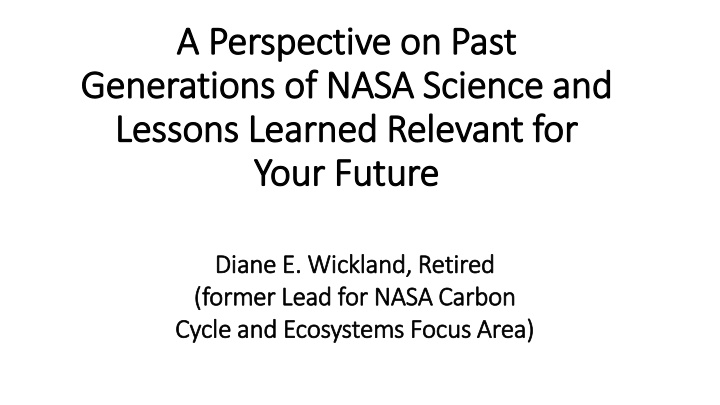

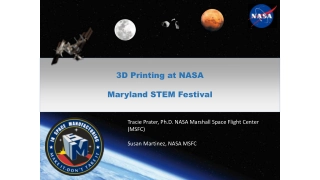
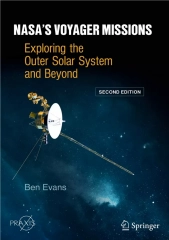
![❤Book⚡[PDF]✔ Doing the Impossible: George E. Mueller and the Management of NASA’](/thumb/21684/book-pdf-doing-the-impossible-george-e-mueller-and-the-management-of-nasa.jpg)
